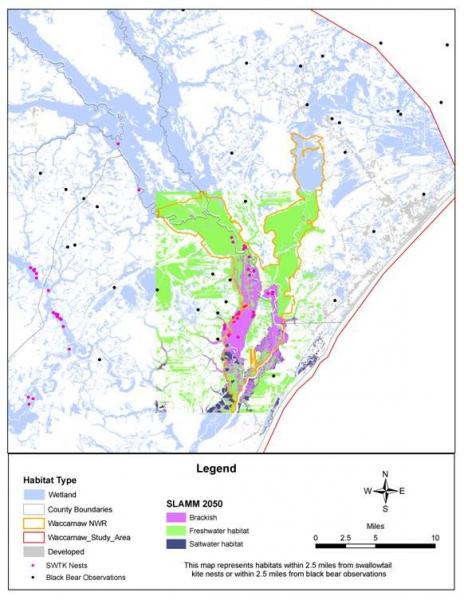Model outputs produced for portions of the Waccamaw National Wildlife Refuge predict that brackish marshes will move inland to areas that are currently freshwater habitat by 2050. The project team worked to identify freshwater habitats further inland that could continue to provide habitat for swallow-tailed kite and black bear.

Setting Conservation Priorities for Preserving Wildlife Habitat
Stressors and impacts
Sea level rise and its potential impact on habitats for native species is a concern for staff at the Waccamaw National Wildlife Refuge on the South Carolina coast. The refuge includes some of the most diverse freshwater wetland systems in the world: it supports the only black bear population east of the Appalachian Mountains, and is home to a population of swallow-tailed kites, a species of bird listed as an endangered in South Carolina. Some portions of the refuge are already becoming inhospitable as habitat due to saltwater intrusion and other sea level rise-related impacts.
Modeling sea level rise to target areas for conservation
A project team concerned with Waccamaw National Wildlife Refuge and wetland ecosystem conservation utilized the Sea Level Affecting Marshes Model (SLAMM) to predict the future distribution of wetlands in and adjacent to the refuge. SLAMM incorporates trends in sea level rise with topographic information to project where marsh habitats will migrate as seas rise. Though SLAMM is typically run at a regional scale, localized data such as local accretion rates, tidal information, and habitat and lidar data were incorporated to make marsh migration projections specific to Waccamaw.
The SLAMM outputs were used in conjunction with the Habitat Priority Planner to target areas for conservation, including key habitats for the swallow-tailed kite and black bear. SLAMM predicts that much of the tidally influenced freshwater wetlands which are the primary home to these species will be lost as sea levels rise. This grim finding has motivated conservationists to search for new inland habitats that may be appropriate for the swallow-tailed kite and the black bear if their existing habitats are lost.
Increasing habitats
SLAMM results are now being used to educate communities on the types of habitat impacts that could result from sea level rise and to target areas at risk of significant habitat destruction. Staff at the refuge and The Nature Conservancy are working with state and local organizations to conserve inland freshwater habitats beyond current refuge boundaries for the swallow-tailed kite and black bear, because existing protected areas will become more brackish with sea level rise. The refuge is also considering expanding its acquisition boundary to be able to continue to study and protect these and other key species.
Adapted from NOAA Digital Coast, "Using Geospatial Techniques to Plan for Climate Change Impacts on Coastal Habitats in South Carolina."
Gentry George, U.S. Fish and Wildlife Service. Public domain, via Wikimedia Commons




